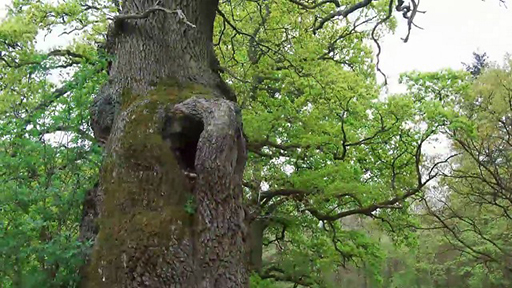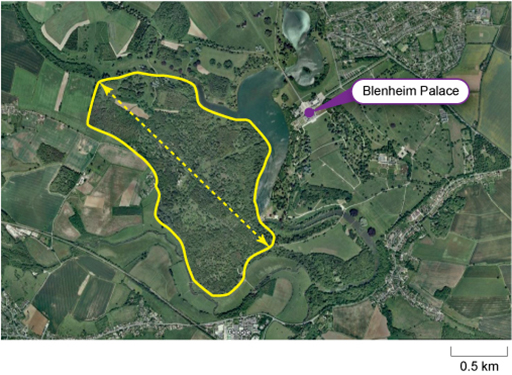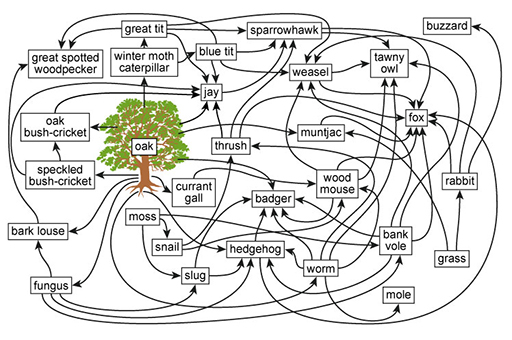2.5 An oak woodland
The following video describes oak woodlands and their history in the United Kingdom. High Park, at Blenheim Palace in central England, is used as an example of a woodland that has been better preserved than in many other areas. Using information from the video you can consider the size of the woodland remnant, how long it has been protected and the implications of these values for conservation.
While watching the video, record the following information to use in the questions that follow:
- the area of High Park at Blenheim Palace in km2
- the span of years since the ecosystem was provided with a first level of protection.

Transcript: An oak woodland ecosystem
Question 1
How big is the area of the oak woodland ecosystem in High Park?
The area of the ecosystem is a two-dimensional measure of space, as outlined by the solid line in Figure 3.

Question 2
From the map in Figure 3, what is the longest length of the main area in metres, as illustrated by the dotted line? Note that you will need to estimate the length and then convert it to the appropriate units.
Question 3
If you assume that the woodland was protected in the middle of King Henry I’s life, by 2017 CE how long had the ecosystem been protected? (Use your notes from the video about the dates of his life to work out the midpoint.)
Question 4
A Forestry Commission report says:
In prehistoric times England was largely covered with woodland. By the end of the first millennium much had already been cleared to satisfy the needs of an increasing population, with the Domesday records showing approximately 15% woodland cover across England. This trend continued, and by the end of the nineteenth century woodland had dropped to below 5%. Since then England’s forest and woodland area has been expanding, and by the beginning of the twenty-first century there were over 1.1 million hectares, equivalent to 8.4% woodland cover.
(Smith and Gilbert, 2001)
Using the dates above, comment on why protected ancient woodlands such as High Park are so valuable. (Your answer should be between 50 and 100 words.)
Answer
The oak woodland ecosystem at High Park was protected around the year 1100 CE. At this time, much woodland in England had already been cleared and about 15% woodland cover existed across England. In the next 1000 years, oak ecosystems were further reduced to 5% cover. High Park was part of this 5% because it was protected from complete clearing. Ecosystem remnants have protected diverse species and provide a model to help the recovery and restoration of oak woodland ecosystems seen in this century.
In the video an example of a food-web was shown, with arrows showing energy flow between organisms (Figure 4). For example, an arrow points from the grass and another goes from the rabbit to the fox, indicating the rabbit gets its energy by eating grass, and the fox obtains energy from eating the rabbit.
Question 5
In Figure 4, the fox has eight arrows pointing to it, indicating that at least eight different organisms form its food supply. If one of those animals were not present in the ecosystem, the fox would have other food choices.
The winter moth caterpillar, currant gall and speckled-bush cricket only have one arrow leading to them, indicating that their food/energy supply entirely comes from the oak. What does this tell us about the value of oaks in the ecosystem? (Your answer should be about 50 words.)
Answer
The single arrow pointing to these species suggests that they only eat oak tissue, so the loss of this plant from the ecosystem would likely mean the loss of the insects that feed on them, as they would not have alternative food sources. This could have further consequences on species that eat the caterpillar, currant gall or cricket.
Question 6
Tables are a useful way to summarise data and can be used to organise calculations. Table 3 shows the areas of broadleaf woodland in England determined by the Forestry Commission in 2001, divided into woodlands with different dominant trees. They have distinguished between areas of woodland that are greater than 0.02 km2 and those that are smaller. Larger areas are considered more resilient because they are more likely to contain closer to the full suite of ecosystem species, including large herbivores that need space, and have an area large enough to resist invasive plants from the edges. The total area of each forest type (the sum of the two area categories) is also given.
Calculate the missing values for areas of woodland in Table 5 (i.e. X and Y) and then select the sentence that correctly interprets the table from the four options below.
| Main species/forest type | Woodland area/km2 | Total area km2 | |
|---|---|---|---|
| Areas 0.02 km2 and greater | Areas 0.001–0.02 km2 | ||
| Oak | 1478 | HighlightedX | 1586 |
| Beech | 606 | 35 | 641 |
| Sycamore | 450 | 38 | 488 |
| Ash | 963 | 86 | HighlightedY |
| Birch | 685 | 11 | 696 |
| Other broadleaves | 896 | 210 | 1106 |
| Mixed broadleaves | 775 | 134 | 909 |
| Total | 5853 | 622 | 6475 |
Question 7
Choose the correct words from the drop-down lists to complete the paragraph below to consider the significance of the preservation of the oak ecosystem in the video, using information from Table 5.
Summary
In this section, you learned about a remnant of oak woodland in the grounds of Blenheim Palace that contains ancient oaks. It is a valuable site because oaks have long lifespans and so the ecosystems in which they occur need long-term protection to persist and allow oaks to reach the large size that supports many other species.
Next: Now look at how oaks colonised the British Isles, or you can return to the size–time explorer [Tip: hold Ctrl and click a link to open it in a new tab. (Hide tip)] and choose for yourself, or use the ‘Next >’ button to go to the next level down on the size scale.

